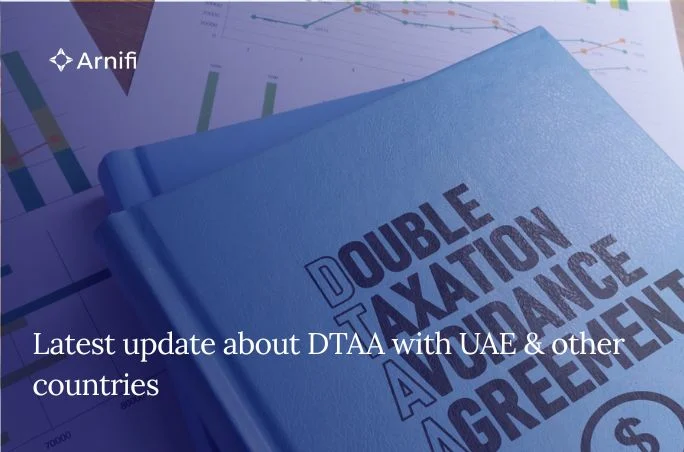Latest Update About DTAA With UAE & Other Countries
by
Ishika Bhandari
Nov 23, 2025  5 MIN READ
5 MIN READ

Table of contents
A double taxation avoidance agreement is a treaty that decides how two countries share taxing rights and how the residence country must give relief.
The UAE has built a wide treaty network, because it wants cross border investment without unnecessary tax friction.
The Ministry of Finance notes that the UAE has concluded around 193 double taxation agreements and bilateral investment treaties with key partners.
What is a Double Taxation Avoidance Agreement?
A DTAA defines who is a resident, what is the source country and which country can tax each type of income. Most treaties then tell the residence country to give relief through the exemption method or the foreign tax credit method.
The OECD and UN models both use these methods so income is taxed once in full instead of twice in full. Treaties also include tie breaker rules so a person who appears resident in both states can be treated as resident in only one.
UAE DTAA Network and Recent Updates
The MoF treaty list shows that the UAE has DTAAs with many Asian, European, American and African partners, including large trading partners such as India.
An interactive dashboard on the MoF site lets users filter treaties by country and download full texts. Recent OECD work on the 2025 update to the Model Tax Convention shows a strong global push to keep double tax relief and dispute rules current.
Many new or updated UAE treaties now follow BEPS standards on treaty abuse and include stronger anti avoidance wording. For residents and businesses this means checking the latest treaty text, not only older summaries or brochures.
What is the Agreement for Avoidance of Double Taxation Between India and UAE
The agreement for avoidance of double taxation between India and UAE is one of the most used DTAAs, because many residents move capital and labour between the two countries.
India and the UAE signed their DTAA in April 1993, and the treaty entered into force in November 1994. The treaty covers income taxes in India and taxes on income, capital and wealth in the UAE that existed when it was signed.
Article 4 of this DTAA follows the usual model approach, with tie breaker rules that look at permanent home, centre of vital interests and other factors when a person is resident in both places under domestic law.
Indian guidance explains that residents can claim treaty relief for income that is taxed both in India and in treaty partners such as the UAE.
How DTAA Relief Works in Practice for UAE Residents
A double taxation avoidance agreement with UAE normally grants lower withholding rates on cross border payments like dividends, interest and royalties.
Domestic law currently sets UAE withholding tax at zero on most outbound payments to non residents, which makes the treaty rate effectively zero for many flows.
Where the other country charges tax at source, the residence country usually gives a tax credit up to its own tax on that same income. Treaties also prevent double non taxation by limiting treaty benefits when a payment is deductible in one state and not included in the other.
Important Double Taxation Avoidance Agreement Income Tax Rules
First is the concept of residence, which is the base for deciding which country gives relief.
Second is the permanent establishment concept, which sets when a foreign business has enough presence to be taxed on business profits.
Third is the relief article, which tells the residence country to exempt foreign income or grant a credit for foreign tax already paid. Scholarly work notes that exemption and credit are the two main global methods for avoiding double taxation of cross border income.
For an individual or company, the practical job is to see which method the treaty uses for each income type and then keep records to support that relief.
Final Advice
DTAAs do not remove tax risk on their own, yet they give a clear rule book for cross border income once the business works following the right laws and keeping the records clean.
If a business or individual earns in the UAE and another treaty country, a careful read of the relevant double taxation avoidance agreement often saves money and avoids stressful disputes later.
Arnifi’s accounting and bookkeeping services in UAE help residents link DTAA rules to clean, verifiable ledgers and filings. This keeps tax relief usable in practice and reduces disputes with authorities over double tax exposure.
FAQs
Q1. Does every UAE resident get DTAA benefits automatically?
No, qualifying as a tax resident is important first and then claim treaty relief using the methods and residency tests in the relevant DTAA.
Q2. Where is the list of UAE DTAAs with other countries present?
The UAE Ministry of Finance hosts a public list and dashboard of all signed double taxation agreements and related treaties, with download links for full texts.
Q3. Does the India UAE DTAA still apply after the new UAE corporate tax law?
Yes, the India UAE DTAA remains in force, and its articles continue to govern how both states share taxing rights on covered income types.
Q4. How to know if the income is relieved by exemption or credit under a DTAA?
Read the relief article, which states if the residence state exempts that income or grants a foreign tax credit up to its own tax.
Q5. Where to start understanding DTAA first?
Start with the definitions article, then residence and permanent establishment rules, then the relief article, using the MoF or CBDT copy as your base text.
Top UAE Packages

Related Articles
Top UAE Packages



